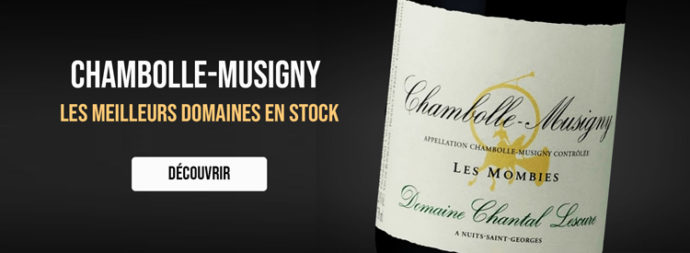The wines of Chambolle-Musigny are located in the center of the Côte de Nuits in the Côte d'Or department, between the Morey-Saint-Denis appellation to the north and the Vougeot appellation to the south.
There are only 152.99 hectares of vines planted in the commune of Chambolle Musigny and produce wines in AOC Chambolle-Musigny, Chambolle-Musigny Premier Cru (There are exactly 24 Premier Crus, with some flagship climats like "Les Amoureuses", and 2 Grands Crus:
- Musigny" grand cru,
- The "Les Bonnes Mares" Grand Cru shows the uniqueness of Chambolle-Musigny, where a Grand Cru is shared with the Morey-Saint-Denis appellation. It is located partly on Chambolle, with 10.5 hectares of vines, and partly on Moret (1.5 hectares).
Chambolle-Musigny: A DELICATE AOC
The wines of Chambolle-Musigny are fine, delicate wines. They are said to be the most feminine and supple wines of the Côte de Nuits. Indeed, the chalky soils and Jurassic subsoil bring their freshness and finesse to the wine, as they do to appellations such as Chablis.
Chambolle-Musigny wines are 99% red wines made from Pinot Noir grapes, but there are a few lucky winemakers who own Chardonnay and are entitled to produce a "Musigny blanc" grand cru.
DOMAINE DE LA POUSSE D'OR
A man's story... Father and son work hand in hand to make Domaine de la Pousse d'Or known the world over.
Although there are written records of the estate dating back to 1789, the estate will take a major turn thanks to Patrick Landanger, who, believing as he does in this magnificent terroir, invested in the estate to restore it to its former glory. He will be assisted by his son Benoït in the winemaking process since 2013, and will hand over management of the family business to him in 2018.
Although the domaine has 4 premier cru climats in Chambolle, as well as the Bonne Mares grand cru, we recommend you start by tasting their village cuvée.
Always with respect for their terroir, as the vines are certified Bio-Dynamic. The estate extracts the fruit beautifully, producing silky, richly mineral wines.
A great start!
DOMAINE JOSEPH FAIVELAY
A domaine to watch if you want to discover the full range of wines Burgundy has to offer.
Even if the estate is not very "confidential", the wines of the Faivelay estate deserve to be tasted. It was in 1825 that Pierre Faivelay set up his wine trading business as a sideline to his trade as a shoemaker. In the late 1840s, he decided to devote himself entirely to wines. Many Faivelays have gone on to run the estate, but it's now the younger generation, the 7th, who are managing the estate. Erwan in 2005, then Eve Faivelay in 2014.
The estate's guiding principle is to produce top-quality, terroir-driven wines.
Chambolle-Musigny 1er Cru Aux Beaux Bruns 2018
Premier Cru Aux Beaux Bruns lies to the east of the Vougeot appellation.
The wine reflects the spirit of this new generation. A powerful Chambolle Musigny, with an aromatic bouquet of red fruits and floral notes.
After a few years' cellaring, the wine will soften, giving way to a different aromatic palette of black fruits and toasty notes.
DOMAINE Amiot Servelle
It's impossible to talk about Chambolle wines without mentioning the name AMIOT SERVELLE.
Although not necessarily a "good investment" given the price level of its bottles, the estate's wines perfectly reflect the appellation.
The estate was created in 1920 by Clément Tachot, who at the time managed a few vines in Chambolle Musigny. After several successions, Christian and Élisabeth Amiot Servelle now run the 7-hectare estate in Chambolle-Musigny, as well as parcels in Morey-Saint-Denis and Gevrey-Chambertin.
CHAMBOLLE MUSIGNY 1ER CRU LES AMOUREUSES - AMIOT SERVELLE
A true benchmark among Chambolle's climats, the "Les Amoureuses" climat lies beneath the Musigny. The wines have great aromatic intensity and complexity. The 18-month ageing period for 50% of the cuvée endows the wine with great ageing potential.
We have chosen to use the word investment, not to advise you to buy this or that bottle in order to make a capital gain in a few years' time, but rather to invest in certain estates or appellations that will be more difficult to access financially in a few years' time.






![✨ Comptoir des Millésimes honors Champagne's great winemakers ✨[LINK TO THE ORGANIC CELLAR]We've selected 11 exceptional estates that reveal the full richness of Champagne terroir through unique, refined cuvées. Hugues Godmé - In Verzenay, this family-run biodynamic estate offers precise, vibrant champagnes with a beautiful mineral tension.Egly-Ouriet - A benchmark for the Montagne de Reims, its powerful champagnes, aged for long periods in barrel, impress with their complexity.Moussé Fils - In Cuisles, the Meunier grape is king. Pertois-Moriset - Pure, taut Chardonnay Grands Crus for lovers of chalky finesse. A fine address in Mesnil-sur-Oger.Geoffroy - In Aÿ, this domaine produces fine champagnes, carefully crafted and barrel-aged to reveal the full complexity of the terroir.Larmandier-Bernier - Biodynamic viticulture, exceptional parcels and purity. Crystal-clear, intense champagnes for connoisseurs.Roger Coulon - Eight generations of expertise at Vrigny. Balanced, subtle and elegant champagnes.A. Bergère - In Avize, a dynamic house offering expressive, fruity and accessible cuvées.Adrien Renoir - A promising talent from Verzy, he produces fine, complex champagnes with a true sense of terroir.De Sousa - Emblematic house in Avize. Richness, depth, long ageing: Chardonnay at its peak.Pierre Paillard - In Bouzy, the family magnifies Pinot Noir with vinous, racy and sincere cuvées.📦 Order now on our website#ComptoirdesMillésimes #Champagne #VigneronsIndépendants #GrandVin #ChampagnesdeTerroir #LivraisonRapide](https://www.comptoirdesmillesimes.com/blog/wp-content/plugins/instagram-feed/img/placeholder.png)